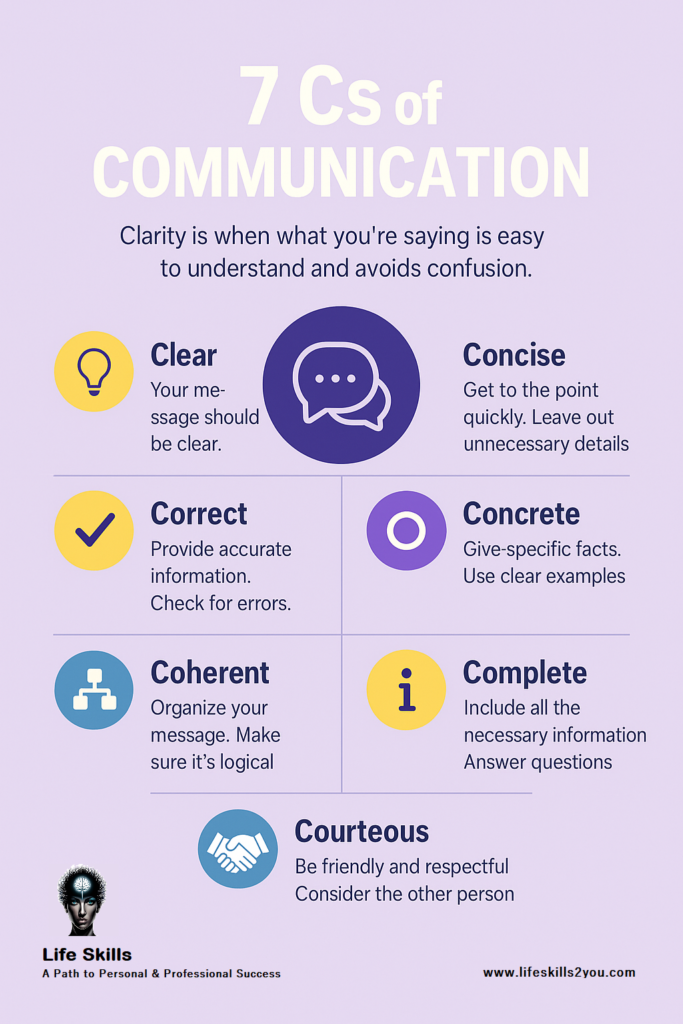Clarity in Communication: The Key to Effective Interactions
Clarity in communication is essential for fostering strong relationships, enhancing productivity, and achieving success in both personal and professional settings. Clarity in Communication ensures that messages are understood as intended, minimizing confusion and improving interactions. 😊📢✅
“The most important thing in communication is to hear what isn’t being said.”
Peter Drucker
Table of Contents
The Importance of Clarity in Communication 🎯💡🗣️
Strengthening Relationships ❤️🤝💬
Clear communication nurtures healthy relationships by reducing misunderstandings and conflicts. Whether in personal or professional interactions, articulating thoughts and emotions effectively builds trust and mutual understanding.
Boosting Productivity 📈🚀🛠️
In workplaces, Communication Clarity accelerates productivity by ensuring that employees understand their tasks, objectives, and expectations. When instructions are precise, teams work efficiently, reducing errors and delays.
Enhancing Leadership 👑🎤🌟
Great leaders excel in Clarity in Communication. Their ability to convey vision, strategies, and expectations in a concise manner motivates teams, fosters collaboration, and drives success.
Aiding Decision-Making 🧠📊✅
Clarity in Communication plays a vital role in decision-making by presenting information succinctly. When facts and options are well-structured, individuals can make informed choices without unnecessary complexity.

The 7 C’s of Communication 🏆📝🔍
Effective communication is guided by seven fundamental principles known as the 7 C’s. These principles help ensure that messages are clear, concise, and impactful.
1. Clarity 🌟💡✔️
Messages should be clear and easy to understand, leaving no room for misinterpretation.
2. Conciseness ✂️📌📢
Keep communication brief and to the point, avoiding unnecessary words or details.
3. Correctness ✅📖✍️
Ensure that the information shared is accurate, error-free, and grammatically correct.
4. Completeness 📋✔️📊
Provide all necessary information so that the recipient has everything required to understand and respond.
5. Coherence 🔄🔗📚
Structure messages logically, maintaining a smooth flow of ideas.
6. Courtesy 😊🙏💬
Use polite language and consider the recipient’s perspective to maintain a respectful tone.
7. Consideration ❤️🤔👂
Understand the needs, emotions, and background of the audience while communicating.
3. Achieving Clarity in Communication: Techniques and Strategies 🎯🛠️📢
Mastering Clarity in Communication requires consistent practice and the application of effective techniques. Here are some key strategies to enhance clarity in communication:
Simplify Complex Concepts 🧩📖🔍
Break down intricate ideas into easily digestible components. Use relatable examples and analogies to bridge the gap between complexity and comprehension.
Organize Your Thoughts 🗂️🧠📌
Before communicating, structure your thoughts logically. A well-organized message ensures that each point seamlessly leads to the next, improving overall coherence.
Choose Your Words Wisely 🗣️✏️📢
Word choice significantly impacts Clarity in Communication. Use precise and concise language while avoiding jargon and technical terms when speaking to non-experts.
Practice Active Listening 👂🎯🤝
Effective communication is a two-way process. Active listening—focusing on the speaker, asking clarifying questions, and paraphrasing—ensures mutual understanding.
Use Visual Aids 📊📌🎨
In presentations, visuals such as slides, charts, and diagrams reinforce messages and enhance audience comprehension.
Clarity in Professional Communication 💼📢✅
In professional environments, Clarity in Communication fosters collaboration, efficiency, and workplace success.
Providing Clear Instructions 📜✅📌
When giving instructions, be specific and detailed to eliminate ambiguity. Clearly outline steps and expectations to ensure smooth execution.
Effective Email Communication ✉️📖📌
Written workplace communication demands Clarity in Communication. Structure emails logically, use bullet points for easy readability, and highlight key takeaways.
Offering Transparent Feedback 🎯🗣️📊
Constructive feedback should be clear and actionable. Avoid vague comments and focus on specific areas for improvement.
Conflict Resolution ⚖️🤝💬
Clarity in Communication is essential when resolving conflicts. Clearly articulate concerns, listen actively, and propose solutions that all parties can understand and accept.
Clarity in Personal Relationships ❤️🗣️💡
Applying Clarity in Communication in personal interactions strengthens connections and minimizes misinterpretations.
Expressing Emotions Clearly 💖🗣️😊
Openly communicating emotions fosters deeper relationships. Clearly articulating feelings and concerns ensures messages are received as intended.
Navigating Conflict Effectively 💭⚖️📢
During disagreements, prioritize Clarity in Communication. Express your viewpoint clearly, listen attentively, and collaborate to find common ground.
Bridging Cultural Differences 🌍👂💬
Cross-cultural communication requires heightened clarity. Be mindful of language barriers and adapt communication styles to enhance mutual understanding.
The Role of Clarity in Public Speaking 🎤📢✨
Public speaking demands Clarity in Communication to captivate audiences and convey messages effectively.
Structuring Speeches Properly 📝🎯📢
Organize speeches with a clear introduction, well-defined key points, and smooth transitions to ensure audience engagement.
Delivering Messages Effectively 🎙️🔊😊
Beyond words, delivery plays a crucial role. Maintain steady pacing, use expressive gestures, and modulate your voice for emphasis.
Connecting with the Audience 🤝👂📢
Tailor speeches to align with the audience’s understanding. Use relatable language and examples to make messages more impactful.
References:
For further insights on communication skills, I recommend exploring articles on reputable website like Udemy. Additionally, you can enrich your understanding by watching empowering YouTube videos from channels like TED Talks.
In a world flooded with information, achieving clarity in communication is paramount. It transcends verbal exchanges, touching every aspect of our lives – from personal relationships to professional success. By understanding the essence of clarity and implementing effective strategies, you empower yourself to be a better communicator. Embrace clarity and watch as your interactions flourish, connections deepen, and your influence grows.
Frequently Asked Questions (FAQs) about the concept of clarity in communication
Q1: How does clarity in communication impact interpersonal relationships?
Ans: Clarity minimizes misunderstandings, fostering trust and deeper connections between individuals.
Q2: Can clarity in communication be achieved in non-verbal communication?
Ans: Yes, clarity extends to non-verbal cues such as body language and facial expressions.
Q3: What’s the connection between clarity in communication and effective leadership?
Ans: Effective leaders communicate clearly, inspiring and motivating their teams toward success.
Q4: How can I improve clarity in my writing?
Ans: Simplify complex ideas, organize your content logically, and choose precise vocabulary to enhance clarity.
Q5: Is clarity more important than brevity in communication?
Ans: While brevity is valuable, clarity should never be compromised. Clear communication trumps all
Q6: How does clarity contribute to conflict resolution?
Ans: Clear communication during conflicts helps parties understand each other’s perspectives and find common ground.


1 thought on “The concept of clarity in communication: Comprehensive Guide.”
Comments are closed.